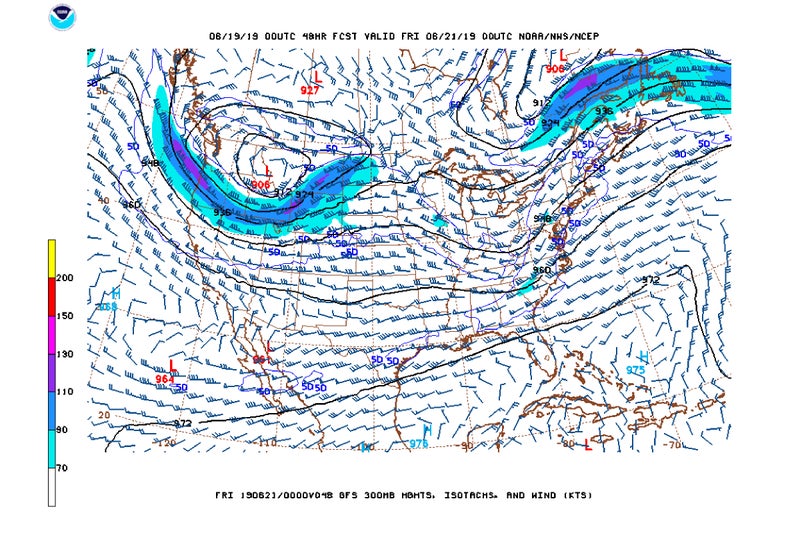According to the National Weather Service, a five-day temperature projection in 2018 as a two-day outlook back in 1988. Now╠řthe accuracy and timeliness of weather forecasts are about to get even better, thanks to╠řthe National Oceanic and Atmospheric AdministrationÔÇÖs (NOAA) to the countryÔÇÖs flagship weather model, the Global Forecast System (GFS), this month. The improvement╠řwill reportedly grow the range of reliable forecasts to a week or longer.
HereÔÇÖs how it works:╠řWhen you check the weather to plan for that camping trip next weekend, the information youÔÇÖre currently looking at comes from meteorologists using computer-based models to predict conditions. However, theyÔÇÖre not just copying those predictions╠řlike a student cribbing answers from a textbook. They only use those for guidance. Each representation has different strengths and specialties, and itÔÇÖs up to users drawing on╠řtheir experience to figure out which ones would help them the most to╠řcreate an accurate forecast.
Some models focus on large-scale weather systems around the world, while others zero in╠řon smaller-scale conditions,╠řlike thunderstorms and sea breezes. The GFS, as its name suggests, operates on a global scale, running four times per day to provide meteorologists around the world with guidance on whatÔÇÖs coming their way.
These models are powered by a dynamical coreÔÇöa collection of mathematical equations that explain atmospheric physics using available data and making╠řpredictions based on that information. ThatÔÇÖs where the GFS is getting a boost.

The GFSÔÇÖs new coreÔÇöcalled (FV3)ÔÇöis designed to partially account for a global modelÔÇÖs general inability to resolve smaller-scale features. The upgraded physical equations in the FV3 give it a more accurate, detailed view of the atmosphere, allowing it to ÔÇťseeÔÇŁ storm systems and different weather features much more clearly than previous iterations.╠ř
There are plenty of perks to building a new foundation for a major weather model. The FV3 core allows it╠řto run faster and more efficiently on new computers, which is necessary for╠řmeteorologists to keep it fresh and current in the coming years. The upgrade will also remedy some clunkiness of the previous versions╠ř(for example, it will offer smoother, more realistic rainfall maps), giving forecasters a truer sense of what the model thinks will happen in a certain area.
Previous dynamical cores couldnÔÇÖt resolve the updrafts that power storm development. The FV3 core gives the GFS╠řthe ability to resolve that issue, a boon to forecasting since thunderstorms have such a large influence over regional weather.
This is not the first time NOAA has upgraded the GFS. range╠řfrom minor tinkering to major overhauls. For example, the resolution quadrupled between 2002 and 2015, and that resolution will likely improve in coming years. This is the first time the core has been upgraded in 40 years.╠ř
NOAA originally planned to roll out this upgrade at the end of 2018, but the government shutdownÔÇöwhich hit the National Weather Service particularly hardÔÇöpushed╠řthe planned release date back to March 2019. That lengthy delay gave meteorologists a chance to in the model, which meant the model routinely ran too cold and produced too many ÔÇťphantomÔÇŁ╠řsnow and ice storms. Experts kept the model on hold for a couple of months until they were satisfied theyÔÇÖd resolved the issues.╠ř
The GFS has lagged behind other countriesÔÇÖ╠řglobal-forecacsting models in terms of overall accuracy. This upgrade is part of╠řthe agencyÔÇÖs╠řEarth Prediction Innovation Center╠řplan to advance what╠ř╠řÔÇťwill advance U.S. weather modeling and reclaim international leadership in the area of numerical weather prediction.ÔÇŁ╠řThe code for the FV3 core will also be available to a wider research community for continuous testing and upgrades for the model.
On a more practical level, having more accurate forecasts a week or more in advance will help╠řeveryone from emergency officials preparing for dangerous conditions to someone planning their next adventure.╠ř╠ř
The GFS and many of its counterparts are from the U.S. government, which means there are a ton of sites out there that offer weather-model output. and are two of the most widely used modeling websites in the field. However, itÔÇÖs only a good idea to check the weather models if you know what youÔÇÖre looking at. For the average user who just wants to check the weather, there are a handful of trustworthy apps available that use the GFS and other sources to make informed forecasts. And they are about to get a lot more accurate.╠ř


